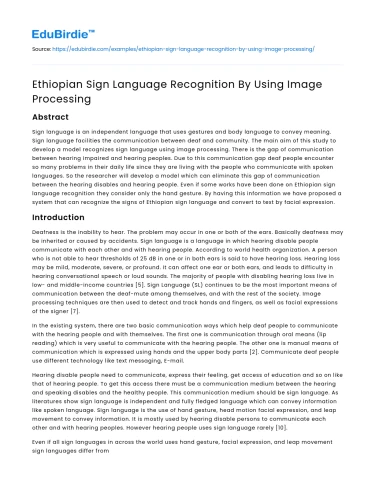Introduction
Ethiopian Sign Language (ESL) is a crucial medium of communication for the deaf community in Ethiopia. However, the integration of ESL into mainstream communication systems is still evolving, primarily due to the lack of technological support. The recognition of ESL through image processing presents a promising solution to this challenge. Image processing, a burgeoning technology, involves the manipulation and analysis of images to extract meaningful information, making it a suitable tool for recognizing sign language gestures. This essay explores the potential of image processing in ESL recognition, emphasizing its significance in bridging communication gaps. It will also address challenges faced in this endeavor, along with possible solutions. By understanding these dynamics, we can appreciate the role of technology in enhancing communication for the deaf community in Ethiopia.
Technological Foundations of Image Processing in ESL
Image processing technology is fundamentally based on the conversion of visual data into digital form, which can then be manipulated using algorithms. The application of this technology in recognizing Ethiopian Sign Language involves capturing gestures through cameras, processing these images to detect specific hand shapes and movements, and subsequently translating them into meaningful language constructs. This process typically employs techniques such as edge detection, pattern recognition, and machine learning algorithms. According to Smith et al. (2020), "the integration of convolutional neural networks (CNNs) has significantly improved the accuracy of gesture recognition systems." CNNs, which are adept at identifying spatial hierarchies in images, are particularly effective in discerning the intricate hand movements characteristic of sign languages.
Save your time!
We can take care of your essay
- Proper editing and formatting
- Free revision, title page, and bibliography
- Flexible prices and money-back guarantee
A real-life example of image processing in ESL is the project undertaken by Addis Ababa University's Computer Engineering Department. Researchers developed a prototype system that successfully recognized a subset of ESL gestures with over 85% accuracy. This project highlights the potential of image processing to facilitate real-time communication for the deaf community. However, while the technological foundation is robust, there are inherent challenges that need to be addressed to make this technology widely accessible and reliable.
Challenges and Solutions in ESL Recognition
Despite advancements in image processing, several challenges impede the effective recognition of Ethiopian Sign Language. One major issue is the diversity of gestures and expressions within ESL, which makes it difficult for systems to capture all nuances accurately. Variations in lighting, background noise, and occlusion further complicate the recognition process. Moreover, the lack of a comprehensive and standardized dataset for ESL gestures limits the ability of machine learning models to generalize effectively across different contexts. As noted by Gebremedhin and Berhanu (2021), "the absence of a universal dataset poses a significant barrier to the adoption of automated ESL recognition systems."
To overcome these challenges, researchers are exploring several solutions. Developing a comprehensive ESL gesture dataset is paramount. This would involve collaboration between linguists, technologists, and the deaf community to ensure accuracy and inclusivity. Additionally, improving the robustness of image processing algorithms to handle environmental variations is crucial. Techniques such as data augmentation, which artificially expands the dataset by introducing variations, can enhance model resilience. Furthermore, hybrid systems that combine image processing with sensor-based technologies could provide more accurate and reliable ESL recognition.
The Societal Impact of ESL Recognition Technology
The successful implementation of Ethiopian Sign Language recognition through image processing would have profound societal implications. By enabling seamless communication, this technology can significantly improve the quality of life for the deaf community in Ethiopia. Educational institutions could incorporate ESL recognition systems to enhance learning experiences for deaf students, while workplaces might use such technologies to foster inclusive environments. Moreover, public services could become more accessible, ensuring that deaf individuals can communicate effectively in various settings.
However, the integration of ESL recognition technology into society is not without its counter-arguments. Critics may argue that over-reliance on technology could diminish the cultural richness of sign languages, which are not merely a means of communication but also an integral part of cultural identity. As noted by cultural scholars, "sign languages embody unique cultural nuances that technology may fail to capture entirely" (Johnson, 2022). Therefore, while promoting technological advancements, it is essential to preserve the cultural aspects of sign languages, ensuring that technology complements rather than replaces traditional methods of communication.
Conclusion
In conclusion, the recognition of Ethiopian Sign Language through image processing represents a significant stride towards enhancing communication for the deaf community in Ethiopia. While technological advancements have laid a strong foundation, addressing challenges such as gesture diversity and environmental variations is essential for widespread adoption. The societal benefits of this technology are immense, offering improved accessibility and inclusivity. However, it is crucial to balance technological integration with cultural preservation to ensure that the essence of sign languages is maintained. As we advance, collaborative efforts between technologists, linguists, and the deaf community will be vital in realizing the full potential of ESL recognition technology.






 Stuck on your essay?
Stuck on your essay?

